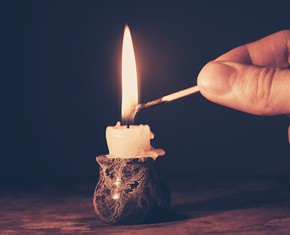The views expressed in our content reflect individual perspectives and do not represent the authoritative views of the Baha'i Faith.
Have you ever taken a trip that changed your life? I have—and I’m still on it. It doesn’t require a ticket, but you will need an itinerary.
Because it’s an inner journey, a trip through the realms of the soul, an itinerary is a must. Why? Well, every inner journey happens in stages. When we embark on the seeker’s path, we travel through different levels of spiritual growth, and each one takes us to a new plane of awareness. It’s easy to get lost, so helps to have a map, so you’ll know where you’re headed.
Just like any journey in the physical world, in our spiritual journey we search for a destination, gain new knowledge when we set out towards it, experience the emotions and the fulfillment of encountering it and then have the peak inner experience that comes with understanding it.
Experts in religious studies say that these developmental ladders in the world’s mystical teachings work in much the same way across all traditions, usually describing between four and ten levels or stages of growth. If you’ve studied mysticism, you’ve probably already encountered some of these numbered, stage-specific ladders of growth. The Baha’i teachings actually present two of those maturational maps, in Baha’u’llah’s short mystical books The Seven Valleys and The Four Valleys.
In The Seven Valleys, Baha’u’llah wrote:
The stages that mark the wayfarer’s journey from the abode of dust to the heavenly homeland are said to be seven. Some have called these Seven Valleys, and others, Seven Cities. And they say that until the wayfarer taketh leave of self, and traverseth these stages, he shall never reach to the ocean of nearness and union, nor drink of the peerless wine. – Baha’u’llah, The Seven Valleys, p. 3.
You’ll notice the phrasing in the first sentence, when Baha’u’llah says “The stages … are said to be seven.” When he wrote “… are said to be …” he referred to a very old tradition, which utilizes a seven-stage model of spiritual attainment, and traces its origins back through Islam, Christianity, Judaism and other Faiths to very ancient beginnings. For the Sufis, the best-known explication of this ancient tradition came from the poet and Sufi mystic Attar, who wrote the legendary literary masterpiece The Conference of the Birds in the 12th Century. The Conference of the Birds also describes seven valleys, which the birds in Attar’s story must pass through to reach their spiritual goal.
While Baha’u’llah addresses the accepted tradition of seven stages of spiritual growth in The Seven Valleys, he seems to favor the shorter, simpler four-stage map of growth in The Four Valleys:
O My eminent friend! Those who progress in mystic wayfaring are of four kinds. I shall describe them in brief, that the grades and qualities of each kind may become plain to thee. – Baha’u’llah, The Four Valleys, p. 49.
In his four-step model of spiritual search, growth and maturation, Baha’u’llah reveals an ancient and yet completely new way of seeing our human progression and growth as a journey of the soul. He presents that journey as a path through four separate valleys, each with its own level of spiritual awareness and realization. A valley, according to Cirlot’s Dictionary of Symbols, represents:
… a neutral zone apt for the development of all creation and for all material progress in the world of manifestation. Its characteristic fertility stands in contrast to the nature of the desert (symbolically a place of purification), of the ocean (which represents the Origin of life but which, in relation to man’s existence, is sterile), and of the mountains (the region characterized by snows and the ascetic, contemplative life, or by intellectual illumination). In short, the valley is symbolic of life itself and is the mystic abode of shepherd and priest. – p. 339.
This perennial philosophy of spiritual growth, which echoes throughout all the major religious traditions, represents the evolving maturity of our being or consciousness as a hierarchy of four steps, stages, dimensions or levels. We move along that maturing path, as the philosopher Ken Wilber says, “from the lowest, densest and most fragmentary realms to the highest, subtlest and most unitary ones.” This ancient wisdom of the four-step or four-fold path has existed throughout religious history, charting our spiritual growth as a maturational quest on the path from self to selflessness.
Those four stages represent themselves scientifically by the earthly classifications of mineral, plant, animal and human. They’re often symbolized by the four elements: earth, water, fire and air. Metaphorically, they stand for the maturation from infant to child to youth to adult. Analogically, they map a gradual progression from inner-directed to other-directed, taking us on a journey of four progressively-maturing phases of life.
But before we go any farther, a big caveat: I am certainly no scholarly expert in understanding Baha’u’llah’s deep, abstruse and complex levels of meaning in The Four Valleys. The English translation of the book leaves much to be desired, because its translation cannot come anywhere close to expressing the poetic beauty, symbolism and richness of the original Persian. Baha’u’llah also utilizes Arabic terms in the introductory sentence of each valley in the book, and those terms have multiple meanings, as well. In virtually every sentence of The Four Valleys, the poetic resonance of the original words loses something in the translation.
So please, regard the analysis and commentary in this series of essays as just my own humble and rudimentary understanding of this remarkable book, and resolve to explore it for yourself to find your own meanings—don’t take my word for it.
In the next essay in this series, we’ll look at the four valleys Baha’u’llah describes, and see if we can draw out at least some of their profound meaning.
















Comments
Sign in or create an account
Continue with Googleor